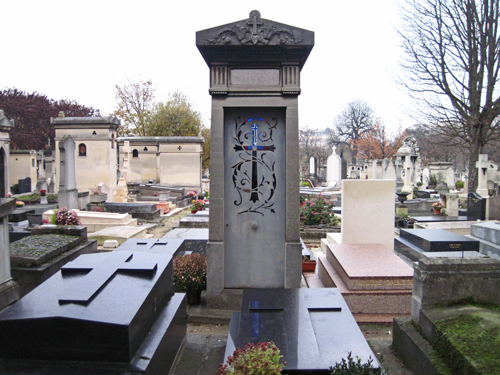People come to Paris for the food, the museums, and the shops, but also for the cemeteries. There is the Pere-Lachaise Cemetery, which opened in 1804 and receives more than a million and a half visitors a year, many of them coming to see the grave of legendary rock singer Jim Morrison.

People come to Paris to shop and eat but also to the cemeteries, such as the Montparnasse Cemetery, in the south of the city. Cemetery visitors may not know it, but they are part of a growing movement known as grief tourism. (Photo by Justin Nobel)
At Montparnasse Cemetery, a grid of mossy tombs and stark stone crosses, are literary luminaries such as Susan Sontag, Guy de Maupassant, Charles Baudelaire, and Jean-Paul Sartre. In Saint-Denis, on the northern outskirts of the city, are buried many of the most famous kings and queens of France, including Louis XVI and Marie Antoinette, who were reinterred here after being removed from their mass grave near the Madeleine. Few people would admit to having come to Paris to see cemeteries, but dark tourism, also known as grief tourism, is a very real phenomenon. Each year, people travel far and wide to see sights linked to some of the world’s greatest massacres. Here are just a few.
Dachau Concentration Camp, Germany – Between 1933 and 1945, more than 31,000 people were murdered at Dachau, the first Nazi concentration camp. It is located near the medieval town of Dachau in southern Germany and is now a memorial site. Visitors can see several rebuilt prisoners’ barracks as well as a number of chapels. Dachau is only about ten miles northwest of Munich, and several local tourist outfits run tours of the camp. “Join us to explore the dark side of Munich’s history,” reads one. “We take you to the site of mass party rallies at Königsplatz and stop in the Hofgarten to talk about The White Rose resistance movement. The tour covers all important facts and sites that played a role in the origin of this black chapter.”
Other Great Reads: Good grief – The path to healing from a loss
Pablo Escobar’s Compound, Colombia – In 1989, Colombian drug lord Pablo Escobar, then in his mid-thirties, was ranked among the world’s ten richest men by Forbes magazine. He was also one of the most murderous, supposedly responsible for more than 4,000 deaths. His massive estate, known as Hacienda Napoles, lay just off the main road between Medellin and Bogota. It had a bullfighting ring and a private zoo with giraffes, elephants, kangaroos and hippopotamuses. On an arch above the entrance was one of the small planes Escobar used to run drugs into the US. In 1993, US Drug Enforcement Agents helped Colombian police gun Escobar down on a Medellin rooftop. After his death, his estate was looted by locals and torched. Convinced gold was hidden around the compound, locals dug up floors, knocked down walls and even burrowed into the concrete dinosaurs. Doors, window frames and bathroom fixtures were carried away. Escobar’s collection of vintage cars was set on fire and many of the exotic animals starved to death. Recently, the provincial government turned the estate into a theme park. His collection of burnt-out vintage cars are still there, as are an entire pod of giant concrete dinosaurs and what has grown into the largest collection of hippos outside of Africa.
“This place is really nice and tranquil,” a 24 year-old university student recently told the BBC as she took a dip in one of the compounds’ two pools. “If one judges him by the estate, you have to say that he was a really intelligent guy.”
Other Great Reads: Narco lives means narco-wives and narco-tombs
Poenari Castle, Romania – The castle was ruled during the 15th century by the murderous Vlad III the Impaler (Vlad Tepes), who was said to have been responsible for more than 80,000 deaths and was the inspiration for Bram Stoker’s Dracula. It is perched on a cliff along a steep river valley on the edge of the Fagaras Mountains, near the village of Arefu. The castle was erected in the 13th century but abandoned during the 14th century. In the 15th century, Vlad III moved in. His father, Vlad II, was a member of a group founded to protect Christianity in Europe called the Order of the Dragon (Dracul). As the son of Dracul, Vlad II was also known as Dracula. He was famous for his excessive cruelty, burning entire villages to the ground and torturing and often impaling his victims. According to one story, an invading Ottoman army turned back in fright when it encountered thousands of rotting corpses impaled on the banks of the Danube.
Sometime during December 1476 Vlad III was assassinated and his head taken to Constantinople as a trophy. His castle fell into disrepair and by the 17th century was in ruins. In 1888, a landslide brought a portion of it crashing down into the river below but most of it remained intact. To reach it today, visitors must take a bus along the Transfagarasan road and ask the driver to stop in a certain spot. One Dracula enthusiast named Manning Krull recently did that and posted about the experience on his blog: “I rode through 20-some kilometers of beautiful hills and farms and tiny villages, going basically in a straight line the whole time, then we reached a point where the bus was going to make a left, and the driver pulled over and gestured to me to get out and walk straight down the road…Soon, on my right, I saw a small house with a carved wooden image of Vlad Tepes!”










Sacha Eachus
thanks for the update